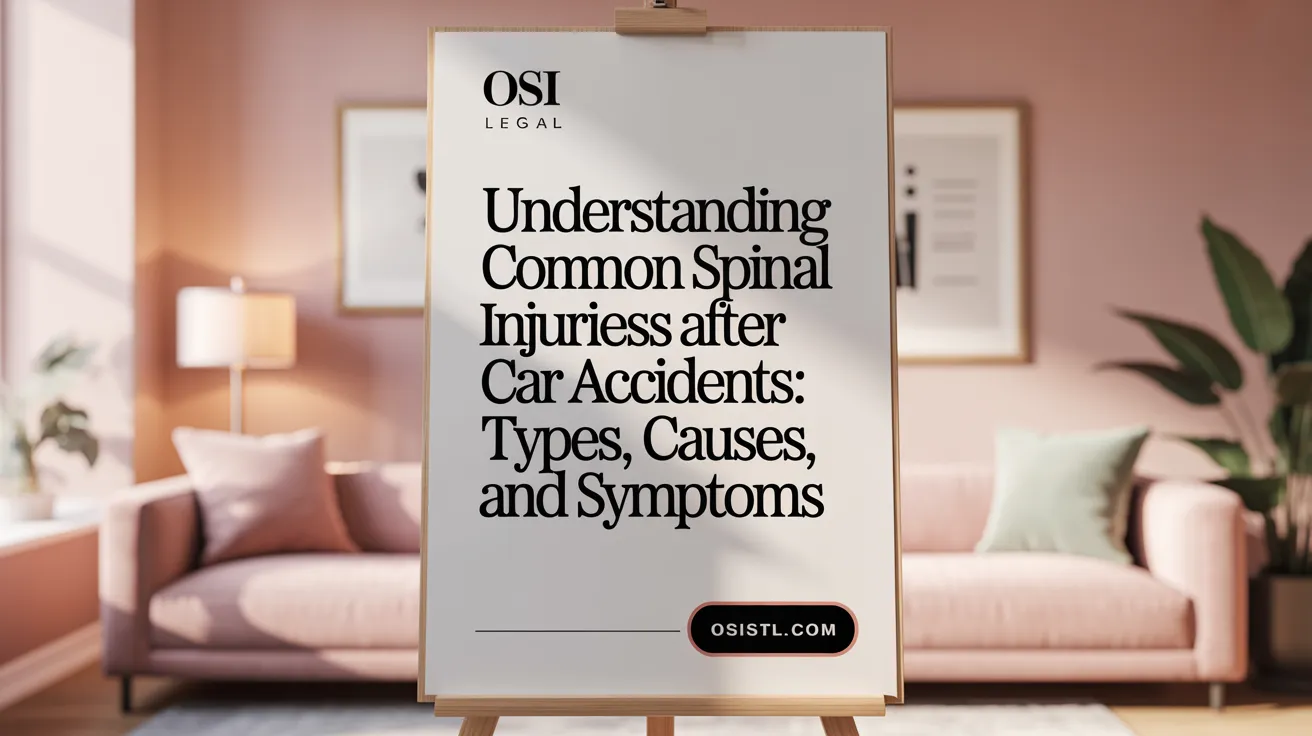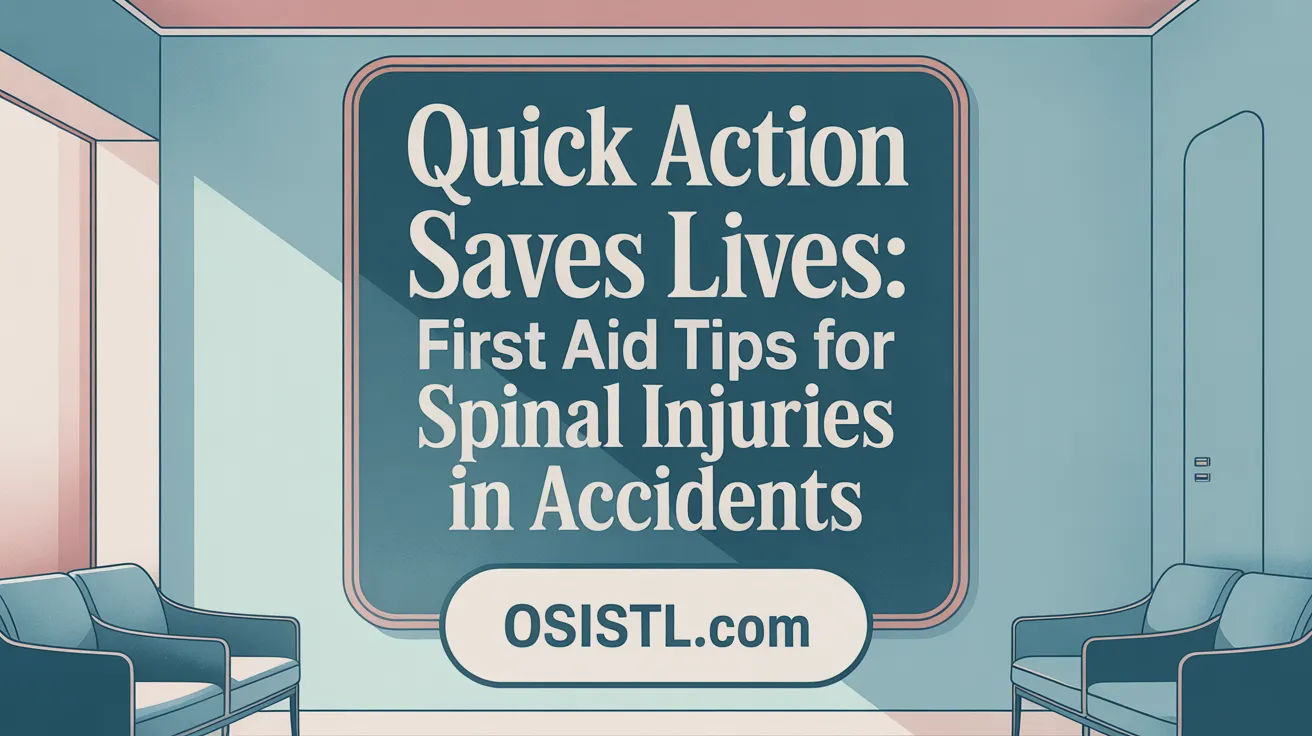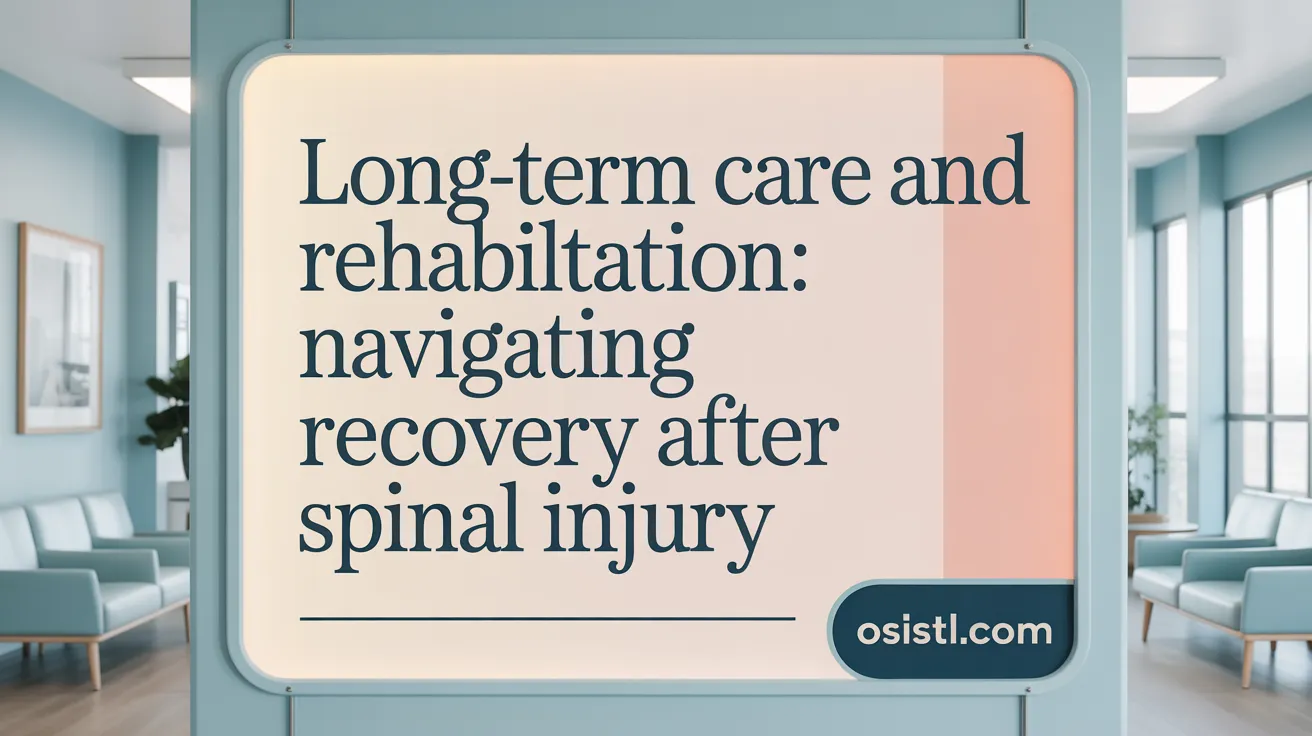Understanding the Critical Nature of Spinal Injuries
Spinal injuries resulting from car accidents are both serious and complex, affecting the body’s core structure and nervous system. With nearly 40% of spinal injuries attributed to vehicle collisions, the trauma sustained can lead to a wide range of physical impairments, from mild discomfort to permanent paralysis. This article outlines the types of spinal injuries frequently seen after crashes, the necessary immediate responses, and pathways for treatment, recovery, and legal recourse, providing a comprehensive resource for victims and caregivers alike.
Types, Causes, and Symptoms of Spinal Injuries After Car Accidents

What are the types, causes, and symptoms of spinal injuries resulting from car accidents?
Spinal injuries linked to car accidents encompass a variety of conditions. Common types include whiplash, herniated or ruptured discs, broken vertebrae, facet joint injuries, spinal stenosis, and more severe damage such as spinal cord injury.
Causes typically involve sudden impacts, rapid acceleration or deceleration, and violent jolts during a crash. These forces can stretch, tear, or fracture the bones and tissues of the spine, sometimes pressing on or severing the spinal cord (Spine injury causes and effects).
Symptoms vary widely depending on the injury type and severity. Whiplash often causes neck pain, stiffness, and headaches (Whiplash injury overview). Herniated discs might lead to radiating pain, numbness, or weakness in limbs (Herniated disc symptoms and causes). Fractured vertebrae can cause significant pain, swelling, and difficulty moving, with risk of nerve damage (Symptoms of spinal fractures). Spinal cord injuries may result in paralysis, loss of sensation, and autonomic dysfunctions such as bowel or bladder control issues (Symptoms of spinal cord injury (SCI)).
Understanding the different injury types, causes, and symptoms helps in timely diagnosis and treatment, crucial for recovery and preventing long-term disability. Prompt medical evaluation, including imaging tests like X-rays or MRI (Imaging techniques for back injury diagnosis), is essential if a spinal injury is suspected after a car crash.
Immediate First Aid and Emergency Response for Suspected Spinal Injuries

Recognizing signs of spinal injuries
Spinal injuries after a car accident may present with severe back or neck pain, muscle weakness, numbness or tingling in limbs, paralysis or partial loss of movement, difficulty breathing, loss of bladder or bowel control, and abnormal body positioning such as the neck or back being twisted or pushed in an unusual way. Prompt recognition of these symptoms is critical in providing timely help and preventing further damage. For more information, see Signs of spinal cord injury (SCI) and Symptoms of spinal cord injury.
Emergency procedures and immobilization
When a spinal injury is suspected, the first step is to call emergency services immediately (911 or equivalent). Do not move the injured person unless there is an immediate danger, such as fire or collapse. The priority is to keep the person still and prevent any movement of the head, neck, or spine.
During emergency response, immobilize the person's head and neck with your hands if trained, or stabilize with improvised supports like rolled towels or heavy blankets placed on either side of the head. Use a rigid spine board or similar device if available, to keep the spine aligned during transport. Avoid any movement that could worsen the injury.
See detailed guidance on spinal injury first aid including keeping the injured person still and immobilizing the spine.
Safe handling and first aid steps
If the person is unconscious but breathing, maintain airway patency without tilting the head back—lift the jaw forward to open the airway. If they are not breathing or have no circulation signs, begin CPR carefully, avoiding any movement of the neck and head.
Only move the individual if they are in immediate danger, and if necessary, do so with multiple rescuers maintaining proper alignment of the head, neck, and body. After stabilizing the person, wait for professional medical personnel to arrive, and provide clear information about observed symptoms and the accident scenario. Proper initial response can significantly improve long-term outcomes and prevent permanent disability. For more on emergency response and spinal injury care, see Emergency diagnostic tests and spinal cord injury treatment and Immediate care for spinal cord injury.
Medical Evaluation: The Cornerstone of Diagnosis and Treatment Planning

Why is it important to seek medical evaluation and diagnosis for suspected spinal injuries after a car accident?
Early medical assessment plays a crucial role in minimizing long-term damage. When a spinal injury is suspected, prompt evaluation helps identify the severity and specific location of the injury, which is vital for guiding effective treatment. Without proper diagnosis, there is a risk of worsening the injury, developing chronic pain, or experiencing permanent nerve damage that could lead to paralysis.
Diagnostic imaging techniques are essential tools in this process. X-rays can reveal fractures or dislocations of the vertebrae, while MRI scans provide detailed images of soft tissues, disks, and the spinal cord itself. These scans allow healthcare professionals to assess whether nerves are compressed, if there is swelling, bleeding, or tissue injury, and to determine the precise extent of damage.
In addition to general imaging, specialized spine assessments are often performed. These may include neurological exams to evaluate motor and sensory function, as well as tests to measure reflexes and muscle strength. This comprehensive evaluation ensures an accurate diagnosis, which is the foundation for developing a tailored treatment plan.
In conclusion, seeking immediate medical evaluation after a car accident—even if symptoms appear mild—is vital. Appropriate diagnosis through advanced imaging and specialist assessments ensures timely intervention, reduces the risk of permanent disability, and optimizes the chances of recovery.
Treatment Modalities for Spinal Injuries: Surgical and Non-Surgical Approaches

What are the treatment options available for spinal injuries caused by car accidents, including surgical and non-surgical methods?
Treatment for spinal injuries resulting from car accidents varies based on the severity and type of injury. Non-surgical options typically include physical therapy, medications such as pain relievers, anti-inflammatories, and muscle relaxants, as well as immobilization techniques like braces or collars to stabilize the spine.
In cases of mild injuries, conservative approaches like rest, ice and heat application, and lifestyle modifications may promote healing and reduce discomfort. Physical therapy is crucial in rebuilding mobility, strength, and function, helping patients adapt to new physical limitations.
For more severe injuries, surgical interventions might be necessary. Common procedures include spinal fusion to stabilize the spine, discectomy to remove herniated disc material, and decompression surgeries to relieve pressure on nerves or the spinal cord. These surgeries aim to alleviate pain, restore stability, and prevent further neurological damage.
The decision between surgical and non-surgical treatment depends on several factors, including the injury’s location and severity, presence of nerve damage, overall health of the patient, and response to initial therapies.
Timely medical evaluation—including imaging like X-rays, MRI, or CT scans—is essential for developing an appropriate treatment plan. It’s also important to follow through with all recommended therapies and follow-up care to optimize recovery outcomes.
Ultimately, personalized care guided by experienced spine specialists ensures the best approach for each individual’s condition, aiming to restore function and improve quality of life.
More insights can be obtained by searching for "Treatment options for spinal injuries after automobile accidents" to find the latest advancements and tailored therapies.
Navigating the Road to Recovery: Rehabilitation and Long-Term Management
 Rehabilitation strategies and multidisciplinary care involve a comprehensive approach to help individuals with spinal cord injuries (SCI) regain as much mobility and independence as possible. Once stabilized in a medical facility, patients typically engage with a team of specialists—including physiatrists, physical and occupational therapists, psychologists, and social workers—who tailor treatment plans to the specific injury level and severity. Initial therapies focus on restoring movement, strength, and daily living skills, while managing pain and preventing further health issues (Rehabilitation after spinal cord injury).
Rehabilitation strategies and multidisciplinary care involve a comprehensive approach to help individuals with spinal cord injuries (SCI) regain as much mobility and independence as possible. Once stabilized in a medical facility, patients typically engage with a team of specialists—including physiatrists, physical and occupational therapists, psychologists, and social workers—who tailor treatment plans to the specific injury level and severity. Initial therapies focus on restoring movement, strength, and daily living skills, while managing pain and preventing further health issues (Rehabilitation after spinal cord injury).
Managing complications and secondary conditions is a critical aspect of long-term care. These may include pressure ulcers, bladder and bowel dysfunction, muscle spasms, respiratory problems, blood clots, and autonomic dysreflexia. Proactive measures such as skin checks, catheter management, and exercising to maintain joint flexibility are essential (Long-term management of SCI). Medical interventions might involve medications, specialized techniques like electrical nerve stimulation, and surgical procedures if needed. Consistent monitoring and prompt treatment of these secondary issues significantly improve quality of life (Spinal cord injury diagnosis and treatment).
The use of assistive technologies and ongoing support enhances daily functioning and emotional well-being. Modern mobility devices—ranging from electric wheelchairs to robotic exoskeletons—are integral in facilitating movement. Adaptive devices help with communication, personal care, and environmental control. Support services extend beyond medical treatment, including participation in community programs, adaptive sports, mental health counseling, and peer support groups (Spinal Cord Injury in an Accident). These resources help individuals adapt psychologically and socially, making the transition to living with SCI more manageable.
Long-term rehabilitation emphasizes adaptation and continuous improvement. It aims to maximize independence, reduce the risk of secondary health issues, and promote mental health. Ongoing education about injury management, environmental modifications in homes and workplaces, and accessible transportation are crucial. Additionally, participating in research and technological advances offers hope for future therapies that may further enhance recovery and function (Spinal Cord Injury Overview and Research). Maintaining hope, motivation, and active engagement in life are essential components of long-term SCI management.
Pain Management and Strategies to Restore Mobility Post-Injury
What tips can help manage pain, symptoms, and restore mobility after a spinal injury?
Managing pain after a spinal injury involves multiple approaches. It often includes medications prescribed by healthcare providers to control discomfort and reduce nerve-related pain. Applying ice packs during the initial stages can help decrease inflammation, while heat therapy may relax muscles and improve blood flow once swelling subsides.
Gentle, gradual movement and stretching as recommended by a physical therapist can boost recovery and prevent stiffness. Maintaining proper posture during daily activities is crucial to avoid aggravating injuries. Adhering to a personalized rehabilitation plan, which may encompass physical therapy exercises, can enhance strength, flexibility, and overall mobility.
Incorporating lifestyle changes, such as ergonomic adjustments, staying active within limits, and avoiding activities that cause pain, supports long-term recovery. Additionally, supportive devices like braces or mobility aids might be necessary during different phases of the healing process.
By combining these techniques with consistent medical guidance, individuals can manage pain effectively, reduce symptoms, and work toward restoring mobility after a spinal injury. For comprehensive guidance, see resources on back injury recovery advice and physical therapy for spinal injury.
How does posture and gradual movement contribute to recovery?
Correct posture minimizes strain on the spine and prevents further injury. Experts recommend focusing on posture correction during sitting, standing, and sleeping. Starting with gentle, supervised movements helps muscles adapt gradually, reducing stiffness and promoting better alignment.
Gradual movement is essential; rushing back to vigorous activity can worsen symptoms or cause setbacks. Following a structured rehabilitation program ensures safe progression in activity levels and supports tissue healing. For more details, see tips for recovering from a back injury and rehabilitation after spinal cord injury.
Why integrate physical therapy with lifestyle modifications?
Physical therapy is tailored to rebuild strength and improve range of motion. When combined with lifestyle modifications—like proper sleep positions, ergonomic work setups, and regular gentle exercises—it enhances healing outcomes.
This integrated approach not only alleviates pain but also empowers individuals to adopt habits that support spinal health long-term. Collaboration with healthcare professionals ensures that these strategies are safe, effective, and aligned with personal recovery goals. Learn more about the rehab process post-accident and pain management techniques to optimize recovery.
Legal Considerations: Protecting Your Rights and Pursuing Claims
When dealing with a spinal injury resulting from a car accident, understanding the legal landscape is essential to secure appropriate compensation and ensure your rights are protected. The first step is to thoroughly document all medical treatments received, including hospital stays, surgeries, therapies, prescriptions, and the overall impact on your daily functions. Detailed records from healthcare providers, along with receipts and bills, form the backbone of a strong legal claim.
Working with an experienced personal injury attorney can significantly enhance your chances of fair compensation. These legal professionals help establish negligence by the at-fault party, gather expert testimonies—such as those from medical specialists or accident reconstruction experts—and navigate complex insurance policies. They also advise on the best strategies to recover damages for ongoing medical expenses, specialized equipment needs, rehabilitation costs, and non-economic damages like pain and suffering.
Timelines are critical; statutes of limitations vary by jurisdiction—often requiring claims to be filed within a set period, such as two years in Oklahoma. Missing this deadline can bar you from pursuing legal action. Additionally, laws related to comparative negligence may influence your compensation if you share some fault in the accident.
Legal proceedings may involve negotiations to settle with insurance companies or, if necessary, filing a lawsuit to seek justice through the courts. Supporting your claim with comprehensive evidence—including medical reports detailing injury severity, expert opinions, and accident evidence—can strengthen your case.
In summary, a proactive approach—documenting injuries meticulously, consulting legal experts promptly, and adhering to procedural timelines—is vital for maximizing recovery and protecting your rights following a spinal injury from a car accident. Being well-informed and prepared can help you navigate the complexities of personal injury claims and secure the compensation needed for your long-term care and recovery.
Resources and Research Updates for Patients and Caregivers
Patients and caregivers seeking the latest information on spinal injury treatment and recovery can turn to a variety of reputable sources. Major organizations like the National Spinal Cord Injury Association (NSCIA) and official government health websites provide comprehensive resources, including educational materials, support networks, and updates on ongoing research. For detailed information on Spinal Cord Injury Overview, Causes, Symptoms, and Treatments, consult the National Institute of Neurological Disorders and Stroke.
Academic publications and peer-reviewed journals such as The Journal of Neuroscience and Advanced Healthcare Materials regularly publish breakthroughs in spinal injury science, including innovative therapies like nerve regeneration, bioengineering, and neurostimulation techniques. Attending conferences or subscribing to newsletters from these groups can keep individuals informed about the newest developments. For a summary of Spinal Cord Injury Diagnosis and Treatments and advances in rehabilitation technologies, refer to the Mayo Clinic resources.
Clinical trials are vital for advancing treatment options. Registries such as ClinicalTrials.gov list active and upcoming studies worldwide, allowing patients to explore participation opportunities that may deliver cutting-edge therapies.
Research funding bodies like the National Institutes of Health (NIH), Wings for Life Foundation, and the Defense Advanced Research Projects Agency (DARPA) support numerous projects aimed at improving outcomes for spinal cord injury patients. Their websites often feature updates on recent progress, new technology, and future directions.
Leading trauma and rehabilitation centers, including those associated with Oregon Health & Science University (OHSU) and the University of Minnesota, are involved in pioneering research involving tissue engineering, stem cell therapies, and neural interface devices. For comprehensive guidance on Rehabilitation after Spinal Cord Injury and regaining function, consult specialized rehabilitation centers.
By accessing these resources, patients and caregivers can stay well-informed about advancements and support options that may enhance recovery and quality of life. Additional practical advice on What to Do After Sustaining a Spinal Cord Injury in an Accident can provide legal and medical guidance for affected individuals.
Taking the First Steps Toward Recovery and Justice
Sustaining a spinal injury in a car accident can have life-altering consequences, but understanding the types, immediate actions, treatment, and legal steps is vital to maximizing recovery and protecting your rights. Prompt medical evaluation, adherence to treatment plans, and engaging multidisciplinary rehabilitation are pivotal in improving long-term outcomes. Additionally, pursuing legal claims with proper documentation ensures access to the necessary resources for care and quality of life support. Staying informed through reliable resources and research advances empowers victims and caregivers to navigate the challenging journey ahead with hope and resilience.
